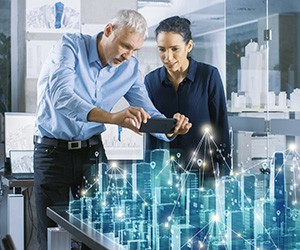The twisting of reality is becoming common practice in the meeting, tradeshow, event and exhibition world.
By using an ever-evolving array of technology such as virtual reality, augmented reality and mixed reality, users can enter worlds created from scratch to entertain, provide demonstrations and eventually sell a concept or product.
But how “realistic” is the implementation of this technology? What is each good at doing and what drawbacks are endemic to which specific medium?
Before you, your exhibitors and attendees pass through the looking glass, arm yourself with a basic knowledge of how this technology performs and whether it will be suited to your meeting, tradeshow or event.
Virtual Reality (VR)
VR is the use of computer technology to create a simulated environment. Instead of viewing a screen in front of them, users are immersed and able to interact with 3D worlds.
VR pros:
- VR, when properly made, can be an incredibly engaging sensory ride. Using computer-generated imagery (CGI), there are no limits aside from money and imagination to create other worlds or to demonstrate products or spaces in novel and interesting ways. VR is the closest technology we have to the Star Trek holodeck, and it will continue to improve rapidly in the next few years.
VR cons:
- VR is a fragmented market. Headset pricing ranges from about $15 (Google Cardboard using a smart phone) to $1,500 (HTC Vive Pro), and many choices with widely varying capabilities in between. VR standards are early in the adoption stage and content created for one platform usually will not work with another.
- VR is a new medium. Content creation tends to be custom and, oftentimes, expensive. Best practices for effective and engaging content creation are still being worked out as well.
- VR is often an isolating, individual experience—it takes you to somewhere else removed from the existing environment. This is the opposite of events where one of the main goals is to bring people together live in a group.
- VR is slow for demos. It takes time to sanitize the headset, to put on and adjust the headset, explain the controls, and for the user to view the content. Even if the content is only two to three minutes, an exhibitor would be lucky to get 15 to 20 people per hour through the system.
Best-use cases:
Despite the several downside issues, there are several ways the technology can be used effectively for exhibitions and events.
- VR site inspections: When used properly, the immersive realism of a VR site inspection of a hotel or a destination can be the next best thing to being there.
- Demos: Despite the slowness, a VR demo can show products in a very engaging way and, oftentimes, in a manner that could not be shown in real life.
- VR booth and stage set design: A large exhibit booth can cost several hundreds of thousands of dollars. Before spending the money, a VR walk-though allows a buyer to see almost exactly how it will look and make changes before building. This is being provided by exhibit and event design companies such as Freeman.
- VR room diagraming: 3D room diagramming has been around for several years. It is a natural step to take this to VR. Companies such as AllSeated are among the first to do this, providing a great way of experiencing how the room will look and feel before the event. It is expected that other room diagramming software companies with more functionality will follow suit in the future.
[Related Content: AllSeated -- The Future of Site Inspection Technology?]
What we won’t see soon at business events:
- VR attendance: The NBA will be streaming basketball games in VR this coming season on a variety of VR platforms for a fee. Facebook’s Oculus Venues has just started to stream limited sporting and concert events. However, VR event attendance is a long way from mainstream adoption due to the fragmentation, lack of standards and high cost of high-end systems. Although there is interest in VR for high-volume events (sports and major concerts), it will likely be years before this will work its way down to the average business event.
Augmented Reality (AR) and Mixed Reality (MR)
- AR is a technology that superimposes computer-generated images on a user’s view of the real world, thus providing a composite view. MR is a form of augmented reality that augments the real world with virtual objects that try to look as if they are really placed within that world (see the IKEA example below). AR can use a number of mediums, including smartphone and tablets, headsets, video walls, projection mapping and telepresence systems.
AR pros:
- AR, when used properly, can provide very useful and engaging information layered onto a real-world scene.
- Basic AR apps using smart phones are well-established. One of the first, Layar, was established in 2009.
- Apple’s latest phones and tablets and its AR developer kit have some very significant new AR capabilities. Newer Google Android phones also have strong AR functionality. Smartphone users can see furniture in their own home before buying (IKEA), find their way to an airport gate (American Airlines AR), play games (Monster Park), see restaurant menu options in rotating 3D before ordering (KabaQ), measure distances very precisely (AR measuring tape) and much more. As these newer phones become widely used, it is likely that AR apps will see mainstream use with lots of opportunities for exhibitions and events.
AR cons:
- AR and MR headsets are pricey (Hololens $3,500 and Magic Leap $2,295). We will not see widespread consumer use until the costs come down substantially.
- AR and MR headsets are geeky looking and will be used only for specific applications and not for everyday use in the foreseeable future.
Best-use cases:
- Product demos using tethered tablet computers: AR can bring a product or a picture to life. It can add video, sound and more. With a preinstalled AR app, all the attendee needs to do is pick up the tablet and engage with the demo. AR developers such as Zappar can open up a range of event-focused gaming, navigation and product and event information details.
- Product demos using attendee phones: Although basic smartphone AR apps have been available for a decade, they have not seen widespread use at events. However, as AR goes mainstream in the consumer market with much greater capabilities than in the past, the opportunities for incorporating AR in product demos, event signage or obtaining other event information in an engaging manner abound.
- AR video walls and mirrors: Incorporating AR in a video display and adding gesture recognition can provide engaging displays that, if done properly, will be guaranteed to draw a crowd at an exhibit booth or other event space. https://bit.ly/2z1mc56
- Telepresence: The projecting of 3D-looking life-size holograph-like images, including people onstage, can be very effective and eye-catching. https://www.avconcepts.com/service/holographic-effects; https://bit.ly/2PK0sEA
- Projection mapping (spatial AR): This is a projection technology used to turn objects, often irregularly shaped, into display surfaces for video projection. There are a number of opportunities to use this at events as evidenced in the two videos:
https://bit.ly/2D8jb60; https://bit.ly/2PjW7Zo - Combining AR with a mobile event app: Currently, this requires two app downloads (the event app and the AR app). Once done, the mobile event app can be connected to launch the AR app automatically within the event app. This can be used for a range of gaming and product and event information applications to increase engagement and provide new functionality within the event app.
- Event wayfinding: Although this is in the development stages, the opportunities for guiding attendees through a venue or exhibit hall could be very helpful in the future.
- Wearable display systems such as Hololens and Magic Leap, although pricy, can be used in a group exhibition setting. https://bit.ly/2OxsDC7
VR, AR and MR will see significant growth over the next few years. Each has its strengths and weaknesses. By utilizing the strengths, event planners, exhibitors and attendees will benefit in many ways at exhibitions and events as they are adopted.
[Read This Next: Talking Trends With Event Tech Guru Corbin Ball]







